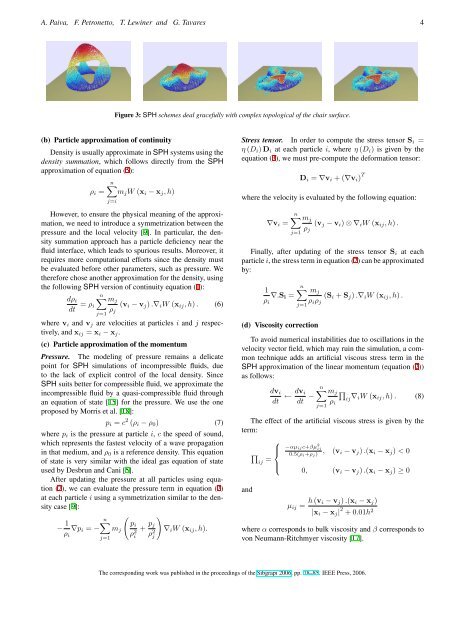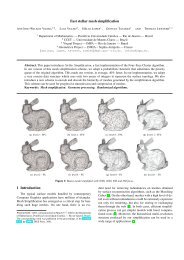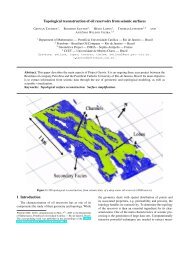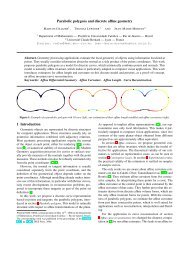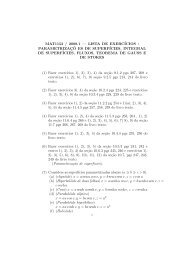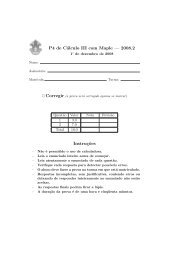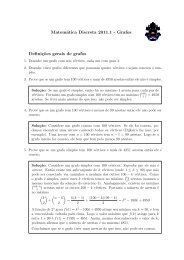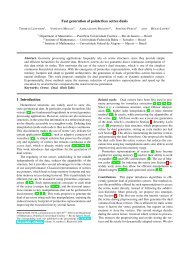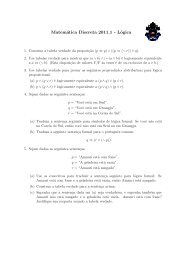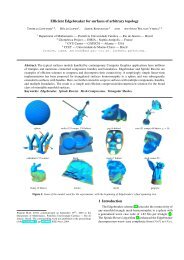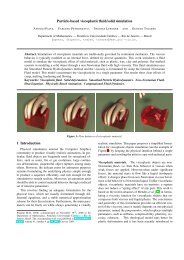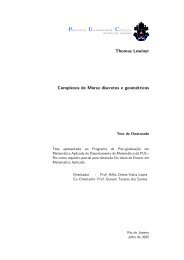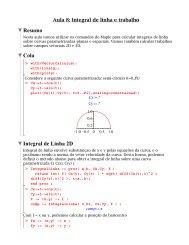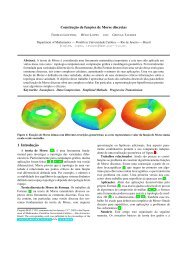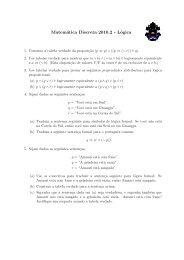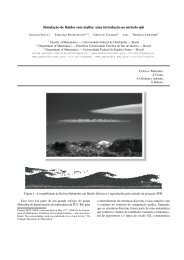Particle-based non-Newtonian fluid animation for melting ... - PUC-Rio
Particle-based non-Newtonian fluid animation for melting ... - PUC-Rio
Particle-based non-Newtonian fluid animation for melting ... - PUC-Rio
You also want an ePaper? Increase the reach of your titles
YUMPU automatically turns print PDFs into web optimized ePapers that Google loves.
A. Paiva, F. Petronetto, T. Lewiner and G. Tavares 4<br />
Figure 3: SPH schemes deal gracefully with complex topological of the chair surface.<br />
(b) <strong>Particle</strong> approximation of continuity<br />
Density is usually approximate in SPH systems using the<br />
density summation, which follows directly from the SPH<br />
approximation of equation (5):<br />
ρ i =<br />
n∑<br />
m j W (x i − x j , h)<br />
j=i<br />
However, to ensure the physical meaning of the approximation,<br />
we need to introduce a symmetrization between the<br />
pressure and the local velocity [9]. In particular, the density<br />
summation approach has a particle deficiency near the<br />
<strong>fluid</strong> interface, which leads to spurious results. Moreover, it<br />
requires more computational ef<strong>for</strong>ts since the density must<br />
be evaluated be<strong>for</strong>e other parameters, such as pressure. We<br />
there<strong>for</strong>e chose another approximation <strong>for</strong> the density, using<br />
the following SPH version of continuity equation (1):<br />
dρ i<br />
dt = ρ i<br />
n∑<br />
j=1<br />
m j<br />
ρ j<br />
(v i − v j ) .∇ i W (x ij , h) . (6)<br />
where v i and v j are velocities at particles i and j respectively,<br />
and x ij = x i − x j .<br />
(c) <strong>Particle</strong> approximation of the momentum<br />
Pressure. The modeling of pressure remains a delicate<br />
point <strong>for</strong> SPH simulations of incompressible <strong>fluid</strong>s, due<br />
to the lack of explicit control of the local density. Since<br />
SPH suits better <strong>for</strong> compressible <strong>fluid</strong>, we approximate the<br />
incompressible <strong>fluid</strong> by a quasi-compressible <strong>fluid</strong> through<br />
an equation of state [15] <strong>for</strong> the pressure. We use the one<br />
proposed by Morris et al. [18]:<br />
p i = c 2 (ρ i − ρ 0 ) (7)<br />
where p i is the pressure at particle i, c the speed of sound,<br />
which represents the fastest velocity of a wave propagation<br />
in that medium, and ρ 0 is a reference density. This equation<br />
of state is very similar with the ideal gas equation of state<br />
used by Desbrun and Cani [5].<br />
After updating the pressure at all particles using equation<br />
(7), we can evaluate the pressure term in equation (2)<br />
at each particle i using a symmetrization similar to the density<br />
case [9]:<br />
− 1 ρ i<br />
∇p i = −<br />
n∑<br />
j=1<br />
m j<br />
(<br />
p i<br />
ρ 2 i<br />
+ p j<br />
ρ 2 j<br />
)<br />
∇ i W (x ij , h).<br />
Stress tensor. In order to compute the stress tensor S i =<br />
η (D i ) D i at each particle i, where η (D i ) is given by the<br />
equation (3), we must pre-compute the de<strong>for</strong>mation tensor:<br />
D i = ∇v i + (∇v i ) T<br />
where the velocity is evaluated by the following equation:<br />
∇v i =<br />
n∑<br />
j=1<br />
m j<br />
ρ j<br />
(v j − v i ) ⊗ ∇ i W (x ij , h) .<br />
Finally, after updating of the stress tensor S i at each<br />
particle i, the stress term in equation (2) can be approximated<br />
by:<br />
1<br />
ρ i<br />
∇.S i =<br />
n∑<br />
j=1<br />
m j<br />
(d) Viscosity correction<br />
ρ i ρ j<br />
(S i + S j ) .∇ i W (x ij , h) .<br />
To avoid numerical instabilities due to oscillations in the<br />
velocity vector field, which may ruin the simulation, a common<br />
technique adds an artificial viscous stress term in the<br />
SPH approximation of the linear momentum (equation (2))<br />
as follows:<br />
dv i<br />
dt ← dv i<br />
dt − n ∑<br />
j=1<br />
m j<br />
ρ i<br />
∏<br />
ij ∇ iW (x ij , h) . (8)<br />
The effect of the artificial viscous stress is given by the<br />
term:<br />
and<br />
⎧<br />
⎪⎨ −αµ ij c+βµ 2 ij<br />
∏<br />
ij = 0.5(ρ i +ρ j )<br />
, (v i − v j ) .(x i − x j ) < 0<br />
⎪ ⎩<br />
0, (v i − v j ) .(x i − x j ) ≥ 0<br />
µ ij = h (v i − v j ) .(x i − x j )<br />
|x i − x j | 2 + 0.01h 2<br />
where α corresponds to bulk viscosity and β corresponds to<br />
von Neumann-Ritchmyer viscosity [17].<br />
The corresponding work was published in the proceedings of the Sibgrapi 2006, pp. 78–85. IEEE Press, 2006.


